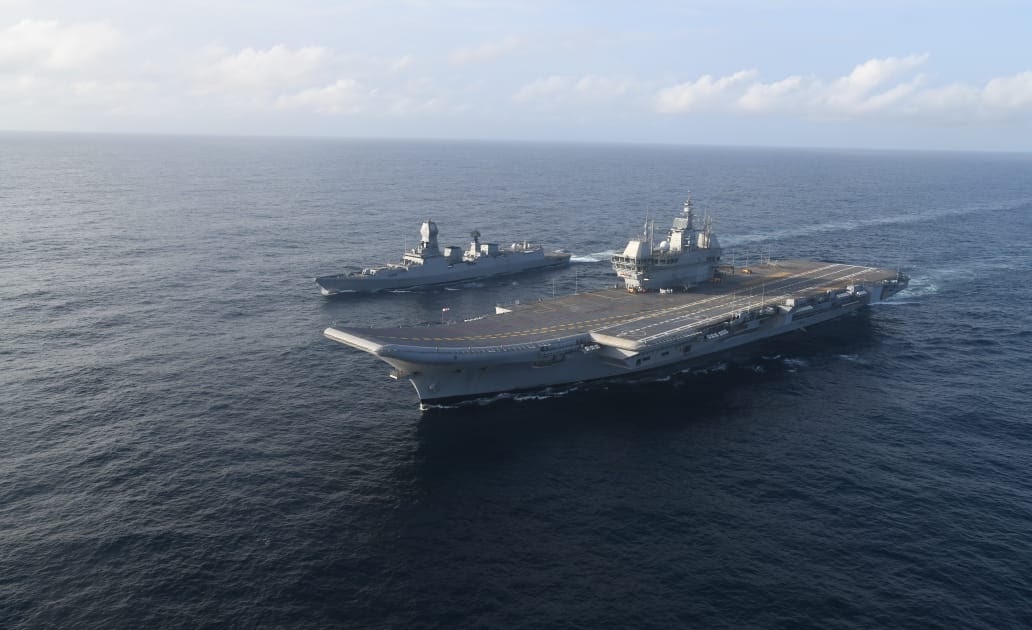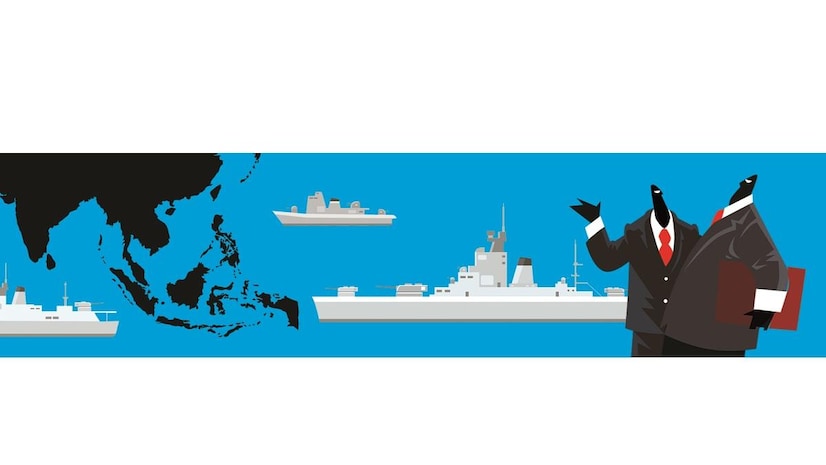
India’s historic focus on its continental borders has overshadowed its maritime ambitions, but that is rapidly changing (above: aircraft carrier INS Vikrant)
By Vikas Gupta
Defence News of India, 5 May 23
As a military influencer, India is a latecomer to the Indo-Pacific region. Yet it has happened, as evidenced by a series of bilateral and multilateral engagements and exercises our Army, Navy and Air Force conduct throughout the year. Each year, our military conducts 62 bilateral exercises and 23 multilateral exercises, raising the skill level and profile of our warriors. Our Navy’s role in securing the Sea Lines of Communication (SLOC) that carry commerce in this region is such that the US military has found it necessary to rename this military theater. Designated since the end of World War II as United States Pacific Command (USPACOM), it was renamed United States Indo-Pacific Command (USINDOPACOM).
It is sometimes difficult to remember that this mutual esteem and cooperation is very recent. It wasn’t until December 2004 that the Indian Navy’s lightning fast response to the Indian Ocean tsunami made USPACOM and the Pentagon realize that having an ally was worthwhile, especially considering given mutual concerns about the rise of an aggressive China. What are the objectives of New Delhi’s Indo-Pacific policy? Besides safeguarding the world’s SLOCs, for which India has assumed the role of ‘network security provider’, there is the threat of piracy, maritime terrorism of the type that hit Mumbai in 2008; smuggling, fishing and humanitarian assistance and disaster relief and search and rescue responsibilities. India also has a huge diaspora, with some 8 million citizens living, working and transferring money from the Gulf. Whenever something went wrong in this unstable part of the world, India evacuated its citizens, beginning with Saddam Hussein’s invasion of Kuwait in 1990-91.
It should also not be forgotten that India supports its overseas citizens with its own dollar. Unlike US allies such as Pakistan, which never fail to present Washington with inflated bills for every counterterrorism patrol they claim to have carried out and for every night vision device damaged, India pays its own bill for the surveillance of Indian Ocean. Additionally, New Delhi currently provides $18 billion in lines of credit for development projects in coastal states.

The decision to use the Indian Navy as a diplomatic tool across the Indian Ocean did not come from diplomats, but from the Navy itself. It was first enshrined in naval doctrine and the Ministry of Foreign Affairs ended up recognizing the particular conditions of maritime diplomacy.
The lag in the development of India’s maritime diplomacy and Indo-Pacific policy raises questions as to why it has taken so long. The answer is: New Delhi was preoccupied to the north. For four decades after independence in 1947, New Delhi’s strategic focus remained on China and Pakistan. The four wars India fought against these two adversaries – 1947-48, 1962, 1965 and 1971 – reinforced what strategists called a “continental mindset”, which was shaped by historical experience centuries of invasions from Central Asia, and then the 19eGreat Game of the Century, in which Britain and Russia competed for influence in Central Asia, Asia Minor and all the way to the borders of British India.
This “continental” perspective – the belief that the threat comes from the north – runs deep in New Delhi. This is so despite the fact that most Central Asian invaders were assimilated into India, lured by the easy life here and the logistical difficulties in repatriating India’s agricultural and textile products.
However, the arrival of maritime colonial powers – the Dutch, Portuguese, French and British – who used large merchant ships to physically repatriate Indian wealth to Europe; and bringing cheap manufactured goods back, which completely destroyed India’s small economies based on craft production, gave India a valuable lesson in the criticality of sea power. It is therefore no coincidence that the struggle for Indian independence began as a campaign against economic exploitation.
But that invaluable lesson was lost on a young, newly independent country in 1947. Some of India’s new rulers had ambitions for naval power, but London believed the Indian Navy should be limited to the defense of the British Commonwealth. This view prevailed, since New Delhi’s precarious finances made it dependent on the Admiralty for warships.
Even so, a fateful decision was made in 1956 that has shaped the Indian Navy ever since. New Delhi has decided to purchase a “surplus to requirements” light aircraft carrier from the Royal Navy, HMS Hercules. Commissioned in 1961, INS Vikrant set the Indian Navy on a path from which it has never strayed since – that of an aircraft carrier power – married to the notion of sea control and projection of power through at least two carrier battle groups – one operating off its west coast and the other off its east coast.
The sea control mindset was best articulated by Henry L Stimson, United States Secretary of War during World War II, who memorably described: “…the peculiar psychology of the [US] Department of the Navy, who frequently seemed to withdraw from the realm of logic in a dark religious world in which Neptune was God, Mahan his prophet, and the United States Navy the only true church.
This church now has one more believer, even though four decades have passed before the Indian and US navies seem likely to pray together. Indeed, in 1962, the year following the commissioning of INS Vikrant, China heavily defeated India. This has bolstered India’s continental mindset, galvanized the modernization of the army and air force, and marginalized the navy. Its share of the defense budget, which had tripled from 4% in 1950-51 to 12% in 1959-60, fell back to 4% after the war.
Paradoxically, this has been the making of the Indian Navy. Unable to afford even the cut-price second-hand ships the Royal Navy offered to sell to India, our first generation of admirals realized they had to create a navy of builders, not buyers. . Whilethe IAF and Army indulged in their love for foreign equipment, the Navy learned to build cheaply in India.
Today, the Navy has made significant progress in hstrong engineering skills. Additionally, the Navy has learned the art of integrating various weapons systems, hand-picked from around the world, on successive classes of multi-role warships. For example, in the Shivalik-class frigates, which began to enter service in 2009, the Navy integrated Russian anti-aircraft missiles Shtil, Russian anti-ship cruise missiles Klub, the Israeli missile defense system Barak- 1 and the Italian Oto Melara 76 millimeter super fast gun mount which India manufactures under license.
During the 1960s and 1970s, as New Delhi realized that an economically declining Britain was an inadequate partner, the Soviet Union supplanted the United Kingdom as the main supplier of warships, technology and of design expertise. The Indian Navy began a love affair with Russia, which still continues, albeit in a different form…especially in strategic areas like the design of nuclear submarines.
Meanwhile, the influence of American design will begin to shape the aircraft carriers of the Indian Navy. The first of the two native carriers, INS Vikrant, bears the seal of Russian design of a ski jump. But a second native carrier, INS Vishal, which is still on the drawing board, will draw heavily on the US carrier’s ethos – larger catapult launch, likely with F/A-18E/F Super Hornets embarked.
Thus, the Indian Navy’s maritime control strategy will likely be based on three aircraft carriers, two of which will be operational at all times. Each will be at the center of a carrier battle group drawn from a total fleet of approximately 175 ships, including approximately 50 capital warships and approximately 600 naval aircraft, including approximately 100 sea-based.
Meanwhile, Russian design and operational assistance will continue in the area of submarines, where Washington refuses to share technology.






